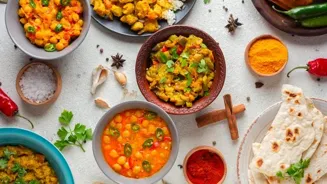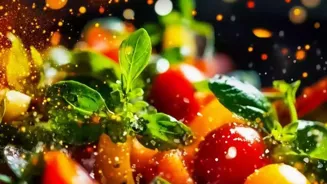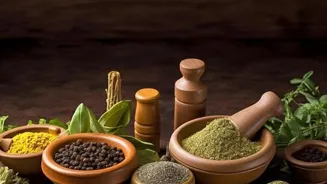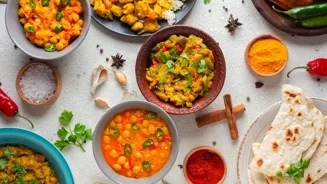Embark on a flavorful journey through the ages of Indian cuisine! From ancient grains to modern innovations, discover the rich history of vegetarian fare. Read on to explore the evolution of Indian food
and the cultural influences that shaped its vibrant flavors
India, a land of vivid colours, diverse cultures, and ancient traditions, also boasts a rich and complex culinary history. Indian cuisine isn't just about spices and flavours; it's a reflection of centuries of history, trade, and cultural exchange.
From the prehistoric times to modern day innovations, the evolution of Indian food tells a fascinating story of our nation. Let's embark on a "culinary time travel" to explore how Indian cuisine has evolved through the ages, focusing exclusively on vegetarian fare.
Origin of Indian vegetarian cuisine in Indus Valley Civilization
Our journey begins in the Indus Valley Civilization (3300-1700 BCE). The people of this ancient civilization were primarily agriculturalists. Evidence reveals they cultivated barley, wheat, legumes, and various fruits and vegetables like dates, melons and peas.
Archaeological finds suggest a diet largely composed of plant based foods. Imagine flatbreads made from wheat, stews of legumes and vegetables seasoned with the early uses of spices like turmeric and ginger, forming the daily sustenance.
Though the preparation techniques may seem rudimentary compared to today's cooking, the foundation of Indian vegetarian cuisine were clearly being laid during this era, with a focus on simple, nourishing meals.
The use of clay ovens and grinding stones were also prevalent techniques of food preparation in those times, further hinting at a focus on naturally sourced ingredients.
The Vedic Period shaped Aryan culture, emphasizing rituals and vegetarianism
The Vedic Period (1500-500 BCE) saw the development of the Aryan culture and the composition of the Vedas. Religious texts described elaborate rituals which included offerings of food to the gods. Meals were prepared and categorized with increased awareness towards their health benefits.
Dairy came to the forefront; with extensive usage of milk, ghee and yogurt. Grains like rice and barley had increased in cultural importance. The concept of "satvik" food, which is pure, clean, and conducive to spiritual growth, began to take shape.
Elaborate feasts and vegetarian meals were a significant part of religious ceremonies, reflecting the growing sophistication of dietary habits. This era marked a cultural shift with vegetarianism gradually growing as a revered practice, influencing our cuisines, as well.
The Mauryan Empire promoted vegetarianism through religion and ethics
The Mauryan Empire (322-185 BCE), under the reign of emperors like Ashoka, saw a broader embrace of vegetarianism. Buddhism and Jainism, advocating non-violence and compassion towards all living beings, gained prominence. Emperor Ashoka's edicts promoted vegetarianism.
This influenced the eating habits of the common people, influencing kings and nobles alike. Plant based foods became increasingly popular, and vegetarian dishes became more refined. The Mauryan era marked significant advancement in plant based cooking.
The emphasis on plant based foods was aligned with religion and ethics. This further cemented the roots of vegetarian cuisine in India.
The Gupta Period: Golden Age of Indian vegetarian cuisine
The Gupta Period (320-550 CE) is often referred to as the "Golden Age of India." We saw significant advances in science, art, and literature. This period saw a refinement of culinary techniques and the introduction of new ingredients.
Detailed recipes and accounts of meals appeared in literary works. This provided insights into the Gupta-era diet. The use of spices like cardamom, cloves, and pepper became widespread, leading to more complex and flavorful dishes.
Furthermore, various methods for preserving and processing food were developed, leading to a more varied and reliable supply of vegetarian foods. The Gupta period was undoubtedly a pivotal era, contributing substantially to the enrichment of Indian vegetarian cuisine.
The Medieval Period in India: Culinary evolution influenced by Central Asian cultures
The Medieval Period (7th-18th centuries CE) marked a transformative phase in Indian history, with interactions with Central Asian cultures that brought in new ingredients and cooking styles.
While non vegetarian food gained prominence in certain circles, vegetarian cuisines evolved differently in various regions. For instance, South India retained its emphasis on rice, lentils, and vegetables, prepared using distinct spices and methods.
North India saw the emergence of rich, creamy dishes, often using dairy products. The Mughal influence led to the adoption of ingredients such as fruits, nuts and saffron in vegetarian dishes, enriching both the taste and presentation.
The period also witnessed the development of sweets and desserts, using sugar, jaggery, and dairy, adding to the diversity of the culinary landscape.
British colonial period transformed Indian cuisine with new ingredients and cooking styles
The British Colonial Period (18th-20th centuries CE) had a complex impact on Indian cuisine. On one hand, it led to the introduction of new vegetables and fruits, such as potatoes, tomatoes, and cauliflower.
On the other hand, traditional cooking methods and recipes also underwent changes due to colonial influences. The rise of processed foods and Western cooking styles, while not predominantly vegetarian, did alter eating habits for some. The British also influenced culinary presentation.
Indians have since adapted and integrated introduced ingredients into their traditional fare to create new dishes and flavours.
Today, Indian cuisine is a beautiful amalgamation of the past and the present; a testament to a culture that has constantly evolved while staying rooted in its principles of vegetarianism.
AI Generated Content. Glance/InMobi shall have no liability for the content








